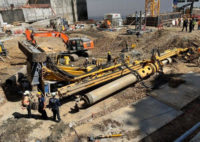New Lima Metro on Track
























A $410-million Lima Metro Line 1 is on pace for completion in June 2011, Peruvian officials say. The 18-month project involves the construction of 11.7 kilometers of new train line and nine stations as well as the complete refurbishment of 9.8 km of existing line and seven stations. Approximately 85% of the civil works for the 22-km-long route are expected to be completed by the end of the year.
The Consorcio Tren Eléctrico, in public-private partnership with the Peruvian government, is the general contractor. Consortium members include the Brazilian construction firm Odebrecht and the Peruvian company Gra�a y Montero, with Siemens Mobility handling electrification of the entire line.
The Peruvian government has underwritten the train project with a $300-million loan from the regional development bank Corporation Andina de Fomento.
In 1985, Alan Garcia was elected president of Peru, and a rail-based mass transit system connecting Lima’s suburbs to the city center was then one of the premier infrastructure projects his government undertook to address the growing infrastructure needs of his nation’s capital.
Despite an auspicious start, the project languished as Garcia’s administration floundered under the dual pressures of an economic crisis that saw inflation surpass 7,000% and a violent internal conflict sparked by Shining Path insurgents. The train project was mothballed as the country struggled for stability.
Since that time, Peru has prospered, and the capital has expanded exponentially as the country’s economic fortunes have improved in recent years. There are now close to nine million people living in Lima’s metropolitan area, almost a third of the country’s population.
According to a study produced by the Brookings Institution this year, Lima was ranked third among world cities in terms of job and economic growth for 2009. During that time period, the country’s GDP outpaced even China’s, growing 9.8%. The infrastructure of the country’s capital city is under immense strain, and the limitations of transportation have hobbled efforts at more efficient development.
Alan Garcia made the rail project a priority in 2006 after his re-election, but efforts to build it as a public project floundered in 2008. In order to complete construction by the end of his term in July 2011, Garcia’s government changed course last year and opened the project to bidders as a public-private partnership.
As a result, when Consorcio Tren Eléctrico was granted the design-build concession last December, it faced a strict 18-month completion deadline. Although the design required a full six months, the consortium was able to start construction within two months of signing the contract.
The consortium initially focused on logistics and public outreach, says Carlos Nostre, Consorcio Tren Eléctrico’s project director, but then the pace quickened as design elements gained approval. Since breaking ground, the contractor has worked three shifts daily on as many as six separate fronts.
Almost all the beams and protective walls for the train route were prefabricated to accommodate an aggressive schedule and a tight urban site.
Current work integrates new construction with unfinished, decades-old construction that still meets current standards of quality. Approximately 45% of the current project included refurbishing existing work, officials said.
The consortium hired the San Francisco consulting engineer T.Y. Lin for seismic studies, a key concern in an earthquake-prone region.
Many existing columns were substantially reinforced, but “much of the new system is built to be somewhat flexible to handle seismic conditions,” Nostre says.
The government is already seeking investors for the second leg of the route, a 12-km-long extension of the current line, which is expected to cost $600 million. When completed, the train system would be able to carry a quarter-million passengers daily, say officials with the State Autonomous Electric Train Authority.
The train system is designed to complement Lima’s recently completed $538-million integrated urban bus system, commonly known as El Metropolitano. Put in service last April, the system features a 26-km primary bus line built in the center lanes of the city’s main north-south arterial roads.
The elevated train is designed to intersect the bus system at the city’s center. When completed, the integrated system is expected to handle more than one million passengers each day.

















